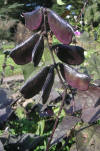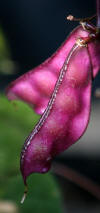

WILD
FOODIES' HOME PAGE
PLANT PROFILE LIST
NAME: Hyacinth bean
SPECIES / FAMILY: Lablab Purpureus / Fabaceae or Leguminosae
OTHER COMMON NAME(S): Indian bean
CONDITIONS:
sun/shade
|
PARTS: |
EDIBLE |
TASTE |
RAW/COOK |
SEASON |
|
All |
|
|
|
|
|
Shoots |
|
|
|
|
|
Leaves |
|
spinach |
COOK |
Spring |
|
Stalk/Stem |
|
|
|
|
|
Buds |
||||
|
Flowers |
|
|
RAW/COOK |
Aug/Sep |
|
Fruits |
|
|
|
|
|
Pods |
|
mild |
RAW/COOK |
Sep/Oct |
|
Seeds |
|
mild |
COOK |
|
|
Nuts |
|
|
|
|
|
Roots |
|
starchy |
COOK |
Fall |
|
Bark |
|
|
|
|
PORTION: small-medium
COMMENT: “Flowers; Leaves; Root; Seed; Seedpod. The mature seed is edible as long as it is thoroughly cooked. It has a mild flavour, is rich in protein and can be used as a staple food. The seed can also be prepared as 'tofu' or be fermented into 'tempeh' in the same way that soya beans are used in Japan. The seed can also be sprouted and eaten raw, when it is comparable to mung bean sprouts. The tender young seedpods and immature seeds can be eaten raw or cooked. They can be used as a green vegetable like French beans. They are also used as a curry vegetable. Leaves - they must be cooked. They can also be dried for later use. The leaves are used as a greens just like spinach. Flowers - raw or cooked in soups and stews. Root - large and starchy.”(1)
CAUTION: “Mature and dry beans have got a high amount of cyanogenic glycosides in them. Not good for you. Mature or dry beans must not be eaten raw. They have to be cooked. That means boiling soft raw mature beans or roasting as heat drives away the toxin. If they have dried — read they are hard — that means soaking overnight then boiling them a long time in a lot of water. Or, boil unsoaked dry beans in a lot of water twice. Actually, that is what one often has to so with many dried beans. And the older any bean is the longer you have to cook it… If I have fresh mature beans — like the green ones right — it’s a long boil in a lot of water or a roast. If I have dry mature beans — also right — it’s a soak and two boils…Also, do NOT drink or use the boiling water. ”(2)
NUTRITION/MEDICINAL:
The immature seedpod contains 3.2% protein, 0.8% fat, 5.4% carbohydrate, 0.81% ash. It is rich in vitamin B1.(1)
The leaves are more than 28% protein, 12% fiber, 7% minerals and 7% fat, eaten freshed or dried. They are an excellent source of iron and magnesium as well as a good source of phosphorus, zinc, copper, and thiamin. Beyond that, sprouts are edible and the cooked root is full of edible starch.(2)
Anthelmintic; Anticholesterolemic; Antidote; Antispasmodic; Antivinous; Aphrodisiac; Astringent; Carminative; Digestive; Febrifuge; Hypoglycaemic; Miscellany; Stomachic.(1)
https://www.webmd.com/vitamins/ai/ingredientmono-1482/hyacinth-bean
LOOK-A-LIKES:
POISONOUS LOOK-A-LIKES:
OTHER USES: Green manure; Plants are fairly fast growing and the bacteria on the roots enrich the soil with nitrogen.(1) Basketry?
SOURCE LINKS (may include nutritional and medicinal info, plus other uses):